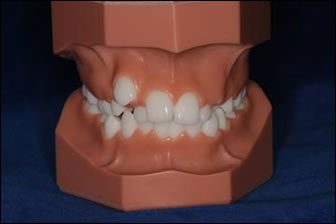What are Dental Orthopedics?
Orthopedics simply put is changing the size, shape, and relationship of the bones of the face and jaws to create symmetry and balance. The simple concept of Orthopedics suggests that dental overcrowding is not due to there being too many teeth, but to the fact that facial growth has not reached its full genetic and growth potential. It takes into consideration airway issues, upper and lower jaw relationship and proper tongue position. Orthodontics simply put is the movement and correct alignment of the teeth.
Both disciplines deal with malocclusion or “bad bite.”
Orthopedics looks at the whole person and as such can be applied to all age groups. Our team will be looking for all aspects of dental, facial, cranial and skeletal structural imbalances. As the baby develops into an infant, external factors (mouth breathing, thumb sucking, ear, nose and throat (ENT) problems etc) effect normal growth. When the baby molars and first permanent molars erupt into contact it locates and locks in the early skeletal development. The teeth will make contact regardless of the size and position of the upper and lower jaws and at this stage, the dental interface becomes essential for the first time. It is possible to interpret the extent of the bony discrepancy for each individual. This is achieved by clinical examination by the Dentist, followed by the taking of study models and cephlometric radiographs.
Causes and Symptoms
What caused the problem In the first place?
No one knows the exact cause of every orthodontic problem. Some causes are very evident, such as thumb sucking. Most are much more complex, However, the old cliche' that the patient inherited daddy's teeth and mother's jaw is simply not correct. You are never too old to be evaluated for craniofacial or dental orthopedic problems. You are never too old to correct a problem non- surgically.
MALOCCLUSION
Malocclusions are usually inherited or acquired.
Acquired malocclusions can be caused by accidents (called "trauma"), sucking of the thumb, finger or pacifiers, tonsils and adenoids that obstruct the airway, and disease or premature loss of primary or permanent teeth.
Inherited malocclusions that determined how well your teeth fit together are largely determined by such attributes as tooth and jaw size. For example, people can inherit large teeth and small dental arches, or the reverse. A "poor bite" is often caused by teeth that have too much or too little room in the jaw. Other common causes of crooked teeth are factors that move the teeth out of place, including oral habits and early tooth loss, which leads to tooth shifting.
Regardless of whether malocclusions are inherited or acquired, many of these problems affect not only alignment of the teeth but also facial development and appearance as well.
SKELETAL DISCREPANCIES
On assessing the face it is possible to see many features that might be construed as not normal, such as:
- Narrow palate with a high arch
- Mouth breathing and poor lip seal
- Lower jaw well behind upper jaw
- Lower jaw well in front of upper jaw
- Lower jaw deviating to one side
- Temperomandibular joint dysfunction
- Overcrowded teeth
SYMPTOMS
Teeth that do not meet normally will lead to the following symptoms.
- ENT problems
- Facial disharmony
- Problems with biting the cheek or roof of the mouth
- Over crowded teeth-permanent teeth erupting out of their normal position
- Poor function of the teeth
- Headaches and various facial pains
- Speech difficulties
- Self- consciousness
Warning Signs: Things to Look For
Facial Asymmetry
When looking at your child from the front does it appear that their face, or chin are shifted to one side. Are they growing crooked?
Earaches
Sometimes a bad bite or a deep bite can cause undue pressure on the small membranes of the ear, contributing to earaches
These are all signs that your child may need early intervention!
Dental Orthopedics works with your child's growth and development to guide the jaws to their proper size.
Treatment
Early Treatment
Early orthopedic treatment usually starts before the eruption of the permanent teeth or when the child has very few permanent teeth present. Our goal is to guide the growth of the upper and/or lower jaw to make adequate space for the eruption of all the permanent teeth. We feel that children should be evaluated by the age of four to see if there is a bone problem (orthopedic) or a tooth problem (orthodontic).
It is always less expensive to correct a problem when the patient is younger rather than wait for the problem to become more serious in the future.






